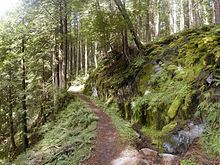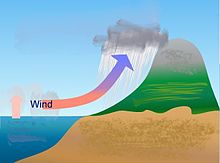Temperate rainforest
The rain forest of the temperate latitudes is a forest - ecosystem that is characterized by a special water balance is characterized. The demarcation to the tropical rainforest is given by its location in temperate climates .
definition
As rainforest forests are drawing more than 2,000 mm in the long-term average precipitation falls annually. In the temperate latitudes, these amounts of precipitation are only reached on the slopes of coastal mountains. Here, inland sea winds lead moisture-saturated air masses against the mountains and force them to climb, which leads to uphill rain .
The maritime climate in the temperate rainforest dampens the seasonal climatic fluctuations, so that the winters are milder and the summers are cooler than inland under the influence of the continental climate . Fog often also occurs in summer , which keeps the forest additionally moist.
Occurrence
Temperate rainforests can develop on the coasts of all continents in temperate latitudes.
There are larger and landscape-defining stocks in:
- North America : The best known is the temperate rainforest on the North American Pacific coast between Northern California (USA), British Columbia (Canada) and the southeastern part of Alaska (USA). Conifers dominate here, predominantly spruce , the giant arborvitae and in California the coastal redwood , the tallest tree species on earth. This includes one of the few temperate rainforests inland: a small occurrence in Canada's Mount Revelstoke National Park .
- South America : temperate rainforests are predominantly on the Chilean Pacific coast - Valdivian rainforest . It consists mainly of cypress plants ( Chile cedar , Patagonian cypress ) and false beeches .
- Australia and Western Tasmania : In the Australian state of Victoria and on the western part of the island of Tasmania south of Australia, temperate rainforests are still expanding today. The eucalyptus predominatesin connection with monimia plants and pseudo-beeches .
- New Zealand : The temperate rainforests are dominated by beeches and holmwood . Tree ferns are typicalin the understory.
- Turkey (Northern Anatolia) and Georgia : In the Colchis region, the species-rich forest of the rain-rich coastal mountains is dominated by beech plants (especially oriental beech , but also sweet chestnut , Iberian sessile oak, etc.), under which various evergreen shrub species build up a second floor.
- Iran and Azerbaijan : Hyrcanic forest on the south coast of the Caspian Sea.
Small forests or remains in special locations can be found in:
Iberian Peninsula : remnants have only survived in gorges, Norway : a few square kilometers in the Trøndelag region as remnants of the Scandinavian coastal needle forest, South Africa (east coast), Brazil (on plateaus); East Asia : In the south of Korea and China , temperate rainforests partially change into tropical rainforests, in the south of Japan there are still remnants of originally pronounced temperate rainforests.
Ecological importance and threat
The temperate rainforest is the most species-rich ecosystem in the temperate climate zone. The high level of biodiversity in the animal world is particularly evident in insects and arachnids, both in the crown layer and in the upper soil horizons . The variety of plant species is different in the various major regions.
Due to the mild climate and the year-round high humidity, biomass production is high, which is why there is regularly a lot of litter , which is worked into the mineral soil by the soil animals. Therefore, large stocks of humus can develop in the mineral soil . On the other hand, thick organic layers (such as raw humus ) hardly form, because what is not worked into the mineral soil by the animals, such as dead wood , is quickly broken down by fungi and bacteria ( destructors ). On the other hand, the high levels of precipitation lead to leaching of the so-called base cations, which is why the supply of nutrients such as potassium , magnesium and calcium is rather low.
As far as there are large areas of contiguous forest areas that are largely undisturbed by human influences , these are often refuge for species displaced elsewhere.
In different regions there are species specially adapted to the habitat of temperate rainforests . A well-known example is the North American spotted owl , Strix occidentalis , which was made by conservationists in the 1990s a symbol of the struggle to protect the last large areas of the temperate rainforest on the northwest coast.
The temperate rainforest is threatened by forestry in many areas . In the large-scale virgin forests, there are often particularly large specimens of popular and therefore valuable tree species.
In North America in particular, the usual form of use is clear cutting , which completely destroys the entire ecosystem. Even if the reforestation is carried out in accordance with the regulations and is successful, the nutrient-poor soils can only be used economically. Despite the higher costs, people often go over to the removal of individual logs (often using helicopters ), through which the entire stock is spared as much as possible.
In the mid-1990s, large areas of the temperate rainforest in the northwest of the North American continent were placed under nature protection. Restrictions on use have been introduced for others, but areas remain open for clear-cutting use.
In Tasmania, intensive mining of copper ore in the north west of the island has threatened the forest. In particular around Queenstown, landscapes without trees or plants emerged. Afforestation programs that started 80 years ago can now point to their first successes, but large areas are still bare.
See also
literature
- Dominick A. Della Sala (Ed.): Temperate and boreal rainforests of the world: Ecology and Conservation . Island Press, Washington DC 2010, ISBN 978-1-59726-676-5 .



